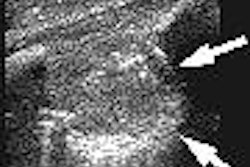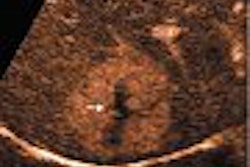Useful as it is, ultrasound for the diagnosis of internal carotid artery (ICA) stenosis can also be confusing. There is debate about the reporting standards for the degree of stenosis, differences in the Doppler parameters used, and differences in the recommended Doppler thresholds.
Unfortunately, a review of medical literature won't necessarily clarify matters, according to Dr. Edward Grant, chairman of the department of radiology at the Keck School of Medicine, University of Southern California in Los Angeles. Grant performed a literature search and found more than 30 articles recommending different Doppler thresholds and 14 that espoused various Doppler parameters.
The 2002 Society of Radiologists in Ultrasound (SRU) consensus conference on carotid imaging, which Grant chaired, was convened precisely to resolve some of these issues and arrive at a consensus.
The issues relate to how stenosis should be reported, which Doppler parameters should be used, and what the Doppler thresholds are. The ramifications for patients are significant. For instance, if stenosis is diagnosed as 70% or higher in a symptomatic patient, performing carotid endarterectomy can reduce the risk for stroke significantly (New England Journal of Medicine, August 1991, Vol. 325:7, pp. 445-453).
"Some of the subjects that we approached were actually of great importance as far as making the diagnosis in these somewhat confusing and controversial areas," Grant said at the 2004 RSNA meeting in Chicago. During a refresher course, Grant discussed ways to hone a Doppler ultrasound practice, with an emphasis on using the modality to determine the significance of carotid stenosis.
Standardization and reporting
All ICA ultrasound exams should be performed with grayscale, color Doppler, and spectral Doppler ultrasound using set protocols from the American College of Radiology, American Institute of Ultrasound in Medicine, or Intersocietal Commission for the Accreditation of Vascular Laboratories standards. It is also important that all members of a laboratory follow the same protocol, according to Grant.
Lack of standardization in equipment -- especially older equipment -- as well as differences between old equipment and new technology can result in different degrees of stenosis being reported by different labs. Using older reporting strata, which don't correspond to the North American Symptomatic Carotid Endarterectomy Trial (NASCET) categories, can also be problematic.
"For example, many laboratories will report 15% or 30% to 49% degree stenosis. You cannot do that with Doppler. Doppler is not capable of identifying stenosis less than 50%," Grant said.
Ultrasound is also incapable of diagnosing the exact percentage of stenosis, he said. He recommended consistently using wide ranges for reporting. The following are the diagnostic strata recommended by the SRU consensus panel:
- Normal
- Less than 50% stenosis
- 50% to 69% stenosis
- 70% to near occlusion
- Near occlusion
- Total occlusion
With 70% being the threshold for carotid endarterectomy according to NASCET, lesions in the group of 50% to 69% are significant, while those below 50% are not so significant. However, these diagnostic strata can be adjusted by laboratories based on standards in their own practice, Grant said.
Doppler parameters
Three Doppler parameters were considered to be significant at the SRU consensus conference: peak systolic velocity (PSV), ratio of the PSV in the ICA to that in the ipsilateral common carotid artery (ICA/CCA), and end diastolic velocity. ICA PSV integrated with grayscale or color Doppler is the primary parameter, supplemented by the two other secondary parameters.
The secondary parameters make up for variations in PSV in instances such as when the patient is hypertensive or atherosclerotic. "If you were to use two of these parameters, I would rely on PSV first, and supplement it by looking at the degree of stenosis as estimated by the systolic ratio," Grant said.
The ROC curves comparing the PSV with ICA/CCA showed the two were almost identical statistically; end diastolic velocity performed slightly lesser, Grant said, discussing studies done at his lab on the Doppler parameters.
"It is important to co-relate all the pieces of information. So look at PSV but then go back and integrate it with the grayscale or color Doppler. If you have a PSV that is 225 cm/sec but you see no plaque, you should be very cautious about considering diagnosis of stenosis," he said.
Doppler thresholds
Doppler thresholds are the single biggest source of confusion in carotid diagnosis. Recommendations range from the 325 cm/sec to 175 cm/sec, according to Grant. Arriving at a consensus on Doppler thresholds was one of the primary reasons for the SRU carotid ultrasound conference.
"Many of the older thresholds or many of the commonly used thresholds in practice are based on pre-NASCET studies. The (SRU) panel looked at this, and we would strongly discourage you from using pre-NASCET thresholds," he said.
Apart from intralaboratory variations and differences in populations, Grant noted that the reason for anomalies in recommended Doppler thresholds was because of the desire for better accuracy, sensitivity, and specificity values in the research studies.
However, Grant pointed out accuracy had no clinical effect on the patient. Also accuracy tended to be more or less stable after it peaked at a certain level, he said. In a previous study, Grant and co-authors found that even maximum accuracy, sensitivity, and specificity (≥ 90%) can still produce different ranges of thresholds (American Journal of Roentgenology, April 1999, Vol. 172:4, pp.1123-1129).
"Sensitivity and specificity are better measures because they have a specific effect on patient outcome," he explained in his RSNA presentation.
In the AJR study, Grant and his colleagues observed that "considerable latitude exists in the choice of carotid Doppler thresholds. We propose a rational strategy for threshold selection based on a combination of three commonly used methods. Our observations indicate that it appears advisable to consider symptomatic and asymptomatic patients separately and to apply appropriately derived thresholds."
Based on the increase in the average Doppler value as the degree of stenosis increases, the SRU consensus panel's recommendations for normal and insignificant stenosis (< 50%) was PSV less than 125 cm/sec, ICC/CCA less than 2, and end diastolic velocity less than 40 cm/sec.
For 50% to 69% stenosis, the recommendations were PSV 125-230 cm/sec, ICC/CCA 2 to 4, and end diastolic velocity 40-100 cm/sec. For 70% stenosis to near occlusion, the recommendations were PSV greater than 230 cm/sec, ICC/CCA greater than 4, and end diastolic velocity greater than 100 cm/sec.
However, "for a particular laboratory setting, internal validation is encouraged when possible. This may yield alternative diagnostic criteria that can be used successfully at that facility," the panel stated (Radiology, November 2003, Vol. 229:2, pp.340-346).
By N. Shivapriya
AuntMinnie.com contributing writer
April 28 2005
Related Reading
Treadmill testing of limited value in diagnosing coronary stenosis in women, April 19, 2005
CREATE results confirm safety, efficacy of new carotid stenosis system, April 5, 2005
New Doppler index may be better for diagnosing renal artery stenosis. March 23, 2005
Copyright © 2005 AuntMinnie.com



















